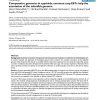1061 search results - page 54 / 213 » Co-authoring with structured annotations |
BMCBI
2005
14 years 11 months ago
2005
Background: The generation of large amounts of microarray data presents challenges for data collection, annotation, exchange and analysis. Although there are now widely accepted f...
BMCBI
2007
14 years 11 months ago
2007
Background: Approximately 5% of Pfam families are enzymatic, but only a small fraction of the sequences within these families (<0.5%) have had the residues responsible for cata...
BMCBI
2006
14 years 11 months ago
2006
Background: Automatic annotation of sequenced eukaryotic genomes integrates a combination of methodologies such as ab-initio methods and alignment of homologous genes and/or prote...
124
Voted
BMCBI
2007
14 years 11 months ago
2007
Background: The Stanford Tissue Microarray Database (TMAD) is a repository of data serving a consortium of pathologists and biomedical researchers. The tissue samples in TMAD are ...
NAR
2002
14 years 10 months ago
2002
SMART (Simple Modular Architecture Research Tool, http://smart.embl-heidelberg.de) is a web-based resource used for the annotation of protein domains and the analysis of domain ar...



